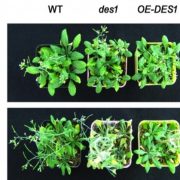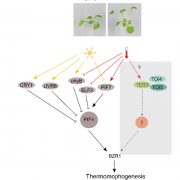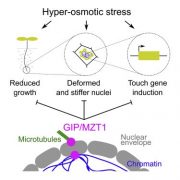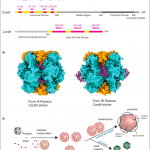Review: Dry architecture: towards the understanding of the variation of longevity in desiccation- tolerant germplasm ($) (Seed Sci. Res.)
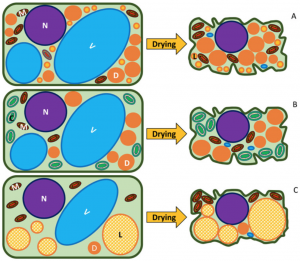 Most seeds, pollen grains, and fern spores are desiccation-tolerant, meaning they remain viable after drying to low water contents. Given this property, they can be stored in cold and dry conditions and potentially remain alive for several years. However, there is increasing evidence that seed longevity in storage conditions might be much shorter than initially thought. In this fascinating review, Ballesteros and colleagues provide an overview of the drying process of desiccation-tolerant germplasm and how the dry cytoplasm’s composition and structure might contribute to viability loss. As germplasm dries, cellular structures are compacted, and cytoplasm becomes a glassy matrix that restricts molecules’ free flow. However, the physical properties of this matrix can be shaped by the composition of the cytoplasm. For instance, chlorophyllous cells’ presence predisposes germplasm to age, given the production of free radicals by chlorophyll in response to light. Moreover, germplasm with high contents of storage lipids tends to age quickly, given that lipid crystallization destabilizes the cytoplasm matrix, allowing the free flow of metabolites throughout it. Given this, the authors highlight the importance of a deeper understanding of dry cytoplasm composition and structure to enhance the development of new germplasms banking technologies that optimizes germplasm longevity. (Summary by Carlos A. Ordóñez-Parra @caordonezparra) Seed Sci. Res. 10.1017/S0960258520000239
Most seeds, pollen grains, and fern spores are desiccation-tolerant, meaning they remain viable after drying to low water contents. Given this property, they can be stored in cold and dry conditions and potentially remain alive for several years. However, there is increasing evidence that seed longevity in storage conditions might be much shorter than initially thought. In this fascinating review, Ballesteros and colleagues provide an overview of the drying process of desiccation-tolerant germplasm and how the dry cytoplasm’s composition and structure might contribute to viability loss. As germplasm dries, cellular structures are compacted, and cytoplasm becomes a glassy matrix that restricts molecules’ free flow. However, the physical properties of this matrix can be shaped by the composition of the cytoplasm. For instance, chlorophyllous cells’ presence predisposes germplasm to age, given the production of free radicals by chlorophyll in response to light. Moreover, germplasm with high contents of storage lipids tends to age quickly, given that lipid crystallization destabilizes the cytoplasm matrix, allowing the free flow of metabolites throughout it. Given this, the authors highlight the importance of a deeper understanding of dry cytoplasm composition and structure to enhance the development of new germplasms banking technologies that optimizes germplasm longevity. (Summary by Carlos A. Ordóñez-Parra @caordonezparra) Seed Sci. Res. 10.1017/S0960258520000239



